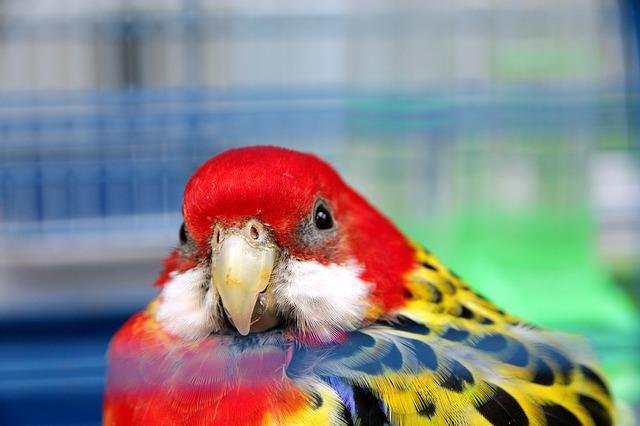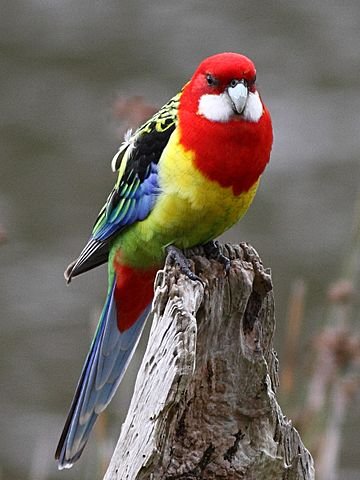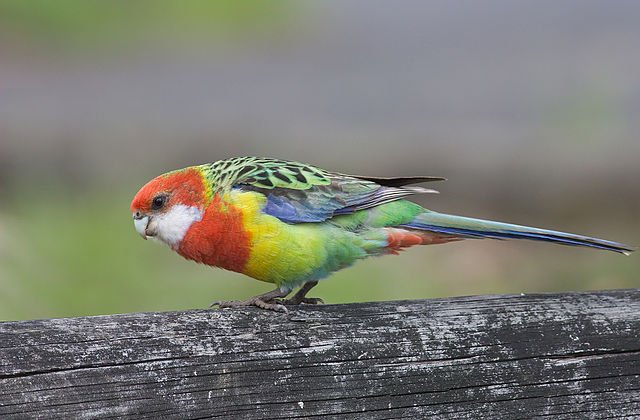The first species to be encountered by the humans, the Eastern Rosellas are loved by parrot lovers for their mesmerizing colors. And this is the same reason they made their name in the pet world. That said, they haven’t been as known as much as some other famed pet parrot species like Quakers, African Greys, and Budgies. Let’s know these living canvases a little better starting right from clearing the confusions around them first.
Eastern Rosella Colors & Markings
To rightly identify an eastern rosella, it’s best to look out for the colors and markings aptly. With three subspecies including the nominate race, here are the details:
Platycercus Eximius Eximius– They can be found in the southern regions of New South Wales and Victoria of the Australian continent. The bird has red plumage on the head and upper breast. The color changes to yellow on the lower breast which merges well into the pale green at the belly. The feathers on the back are black with green margins. The outer wing coverts are blue and the under-tail coverts red. The rump is the paler shade of green. The cheeks have white patches. The bill is also white. The eyes are brown.
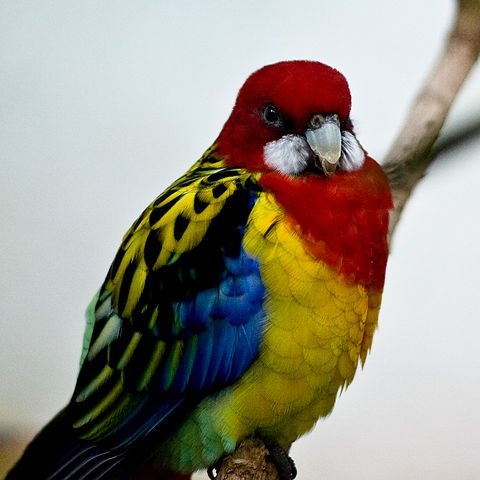
Platycercus Eximius Elecica- There are a few differences between the nominate species and the P.e. Elecica. The rump is greenish-blue along with the similar colored upper tail coverts. There are golden-yellow margins on the black feathers on the back of the male and greenish-yellow margins in the case of females. The subspecies is famously known as Golden-mantled Rosella. They can be spotted in southeast Queensland and northeastern New South Wales.
Platycercus Eximius Diemenensis– Found abundantly in the eastern region of Tasmania, P.e. Diemenensis haven’t many different colors and markings on their plumage except:
A darker shade of red on the head; and
Noticeably larger white patches on the cheeks.
Eastern Rosella Mutations– Apart from the three subspecies, the species has a few notable color mutations too. A few of them are Cinnamon, Lutino, Pastel, Opaline, Pied, Black, Dilute, et al. And there have been instances of breeders trying new mutations with the help of what has been already achieved until now.
Eastern Rosella Lifespan
The lifespan of eastern rosellas exhibits huge disparity with varying habitat. While in the wild, they tend to live for around 15 years or more. And this lifespan doesn’t include any special care or diet as being fed to them in the wild. So, how long does an Eastern Rosella live for? While in captivity, an eastern rosella can average around 20 years or more. But there have been many instances of them living for 27-30 years with a great diet and utmost care. So, this happens to be pretty subjective. Add toys and daily play-time to it, they can prove to be an extremely long-term companion.
Eastern Rosella Talking Ability
Unlike many other parrot species, eastern rosellas aren’t known to be the best talkers of the rosella family or for that matter, even the parrot kingdom. So, can Eastern Rosellas talk? The answer is not much. They can be taught to say a few words but expecting an eastern to be as good as an African Grey or Quaker is unreasonable. However, they have been known to be great whistlers. Their favorite activity is imitating the songs and other sounds of the surroundings and turning them into pleasant whistles.
Eastern Rosella Diet
While in the wild, eastern rosellas show a great liking for fruits and flowers. And the next in line are seeds and insects. And with all this, they live for just 15 years, way too less than in captivity. But what do they need while in captivity?
What do Eastern Rosellas eat?
If the motive is to attract a rosella into a backyard garden like many others, the best way is to plant what rosellas are most attracted to; flowering plants. A few best options are eucalyptus, melaleucas, Callistemon, wattles, grevilleas, and such other native flowering plants. For the seeds, plant Pultenaea and such other seed produce.
To feed a pet eastern rosella, try to strike a proper balance of all the nutrients by offering them everything. If the bird is a fruit lover, due to his natural inclination, offer him a palate of the above-mentioned fruits, solely or as a fruit mix. They also like cucumbers, sweet potato, spinach, lettuce, and kale from the vegetable section. Soaked chickpeas are just another favorite of many eastern rosellas in captivity. But if the bird happens to be a ‘seed addict’ like many pet eastern rosellas, here are the few instructions to follow:
- Sprout the seeds before serving. This would not only eliminate the excess fat but also add nutrition in the form of proteins, minerals, vitamins, and enzymes.
- Prefer the oil seeds like rapeseed or niger as when soaked and germinated, they offer more carbohydrates and protein content against the starchy seeds like millets and canary, which are high in carbohydrates but low in protein.
Treats for Eastern Rosellas– Boiled eggs and nuts serve as a great treat for the eastern rosellas. But do not forget to offer these in very small quantities and only once in a while.
What do baby Rosella birds eat?
A baby rosellas’ diet is different from an adult bird. The best baby eastern rosella diet is a market made food formula that has a just balance of everything that the chick needs for optimum growth. And since the baby rosellas are unable to eat on their own, these formulas are best fed with the help of a syringe. Just two servings a day are enough to fulfill their daily dietary needs or serve them as prescribed on the package.
What fruit does Eastern Rosellas eat?
Eastern rosellas love to feed on non-native fruits like blackberries, mangoes, apples, and oranges. These happen to be their few favorites. But if it is not possible to offer any of these for non-availability, offer them any of the following:
- Papaya
- Bananas
- Peaches
- Grapes
- Pomegranate
- Passion Fruit
- Watermelon
- Citrus Fruits
Eastern Rosella Gender Differences
Eastern Rosellas belong to the monomorphic parrot species, i.e. those species where male and female birds are identical in appearance. Telling an eastern rosellas’ gender accurately by just having a look at the bird is extremely tough and almost impossible. The best way to do so is by DNA testing. But many experts claim to distinguish between them by sexing them visually.
How can you tell if a Rosella is male or female?
If visual sexing is the way one wants to choose as a trial and error method, there are a few ways that experts claim to be accurate almost always:
- The red on the head and chest are a brighter shade in case of male eastern rosellas, contrary to the females that have duller plumage there;
- The white patches on the cheek are more bright and white in case of male eastern against the female that sport duller or off-whitish patches.
- The bills of the female bird are rounder and smaller when compared to those with the males.
- Lastly, the shape of the head can also go a long way in telling an eastern’s gender apart with males having flatter, larger, and broader head and females having smaller and rounder ones.
Eastern Rosella Male
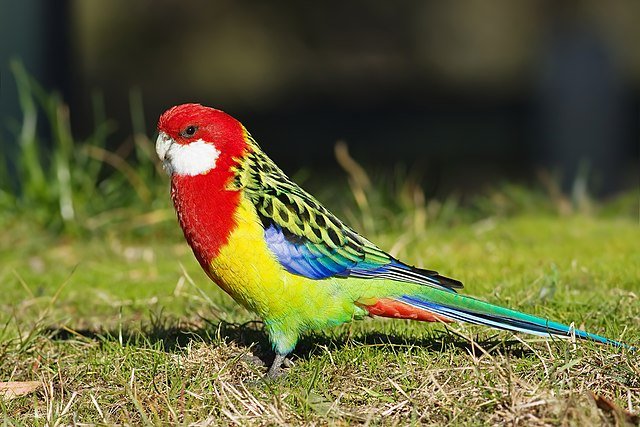
Eastern Rosella Female
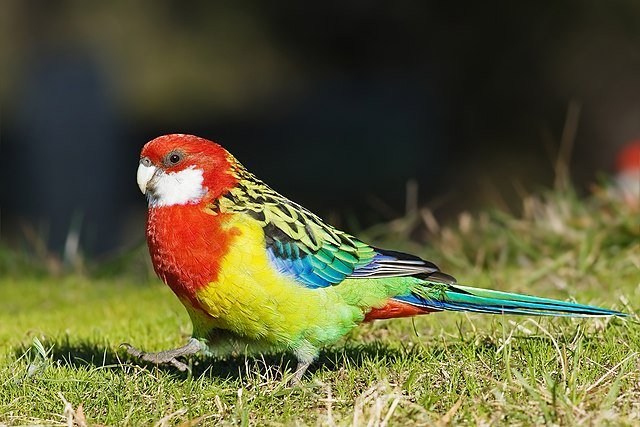
Eastern Rosella Price
Eastern Rosellas aren’t as premium as some other parrot species. Their affordability can be attributed to their wide distribution and easy breeding across the globe. That said, their prices vary in different countries. Here’s an idea of their price range:
Eastern Rosella price in the UK– The bird can be adopted for as low as £100. There are also a few mutations available like that of Golden-mantled Rosella (subspecies). Check News Now for reference prices.
Eastern Rosella price in the USA– The USA is probably the biggest market for eastern rosellas with people demanding even various eastern rosella mutations. Where usual nominate species or subspecies can range anywhere between $300 to $500 (check Bird Breeders), the various mutations can command upwards of the base price (check Hook Bills For Sale).
Eastern Rosella price in Australia– One can have a pair of eastern rosella in Australia for as low as AUS$ 60. Such low prices can be accredited to the fact that the species is native to the continent. Check out Gum Tree for further information.
Frequently Asked Questions about Eastern Rosellas
Many myths are plaguing eastern rosella facts. And the strangest of all being the bird not being a parrot at all. Others relate to their origin and mix-up with other similar species.
Is a Rosella a parrot?
Rosella is undoubtedly a parrot. The whole genus is divided into six species and 19 subspecies including the nominate species too. All these species have been classified into three groups, namely; white-cheeked, yellow-cheeked, and Blue-cheeked. The eastern rosellas belong to the first one. All rosellas belong to the genus Platycercus of parrot kingdom as recognized in the year 1825.
Can Rosellas live with budgies?
Rosellas are a bit aggressive when compared with budgies. They like to mark their territory quite strongly and guard it fiercely. Contrary to this, budgies are comparatively gentle and lesser territorial. And housing them together, especially in a small or medium-sized cage might prove fatal for the little parakeets aka budgies. Though rosella and budgie can thrive together happily for most of the time, it could be harder on rough days. If they end up picking up a fight, the rosella might end up hurting the budgie badly.
Are Eastern Rosellas native to NZ?
Contrary to the popular belief, Eastern Rosellas are not native to New Zealand. They were first spotted in 1792 in the Rose Hill area of Greater Sydney, New South Wales. It was much later around the early 1900s that they were introduced to New Zealand. It all started from 1910, with rosellas introduced to Dunedin, to Auckland around 1920, and Wellington in the 1960s. Their population thrived so well in these regions that they are now thought to be from New Zealand originally.
Are Rosellas a pest in NZ?
Rosellas were first introduced in New Zealand as the ship carrying them wasn’t allowed to take many species like eastern rosellas through the borders. Thus, they were made to escape in the open. Their incessant breeding thereon, naturally and commercially, led to an extreme spike in their population through the length and breadth of the country. Also called common rosellas for their abundant population, they have been declared a pest in NZ due to the following reasons:
- Their feral populations have been known to damage the crops and orchards in the country;
- They have been known to strip the flowers off of some native fruit trees;
- They are infamous for spreading the deadly PBFD or Parrot Beak and Feather Disease;
- They have been competing with the native species for food and water resources; and
- Destroy the nature and recreational environments in the urban areas.
Are Eastern Rosella and White-cheeked Rosella the same?
Both of these species have been known to be aliases of the same species. But this notion is far from the truth. White-cheeked Rosellas are the hybrids of Eastern Rosellas (Platycercus Eximius) and Pale-headed Rosellas (Platycercus Adscitus). Since the ranges of both the parent species overlap in the Southeastern Queensland and northeastern New South Wales, white-cheeked rosellas’ sightings are often confused with the Eastern Rosellas.
Summing Up
Eastern Rosellas are enjoying their new-found fame as a pet today. It has only been lesser than a decade that their demand in the pet world has grown exponentially even outside their native continent. So, are they as good as other pet parrot species?
Are Eastern Rosellas good pets?
Eastern rosellas are fun, playful, and loyal companions. They love to entertain others and stay entertained. But the only way they can be fun is when they are having fun themselves too. They need to be hand-raised well with a lot of love and dedication. Soon after, the bird is often seen riding around the shoulders of their favorite human. Keeping them happy is the key.


